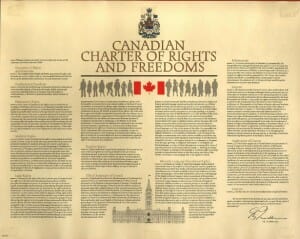On the Charter’s 32nd birthday, let’s celebrate our ‘revolution in law’
April 17, 2014

 Today, April 17, the Charter of Rights and Freedoms celebrates its 32nd birthday. This great addition to Canada’s Constitution is worth celebrating given its transformative impact not only on our laws, but on our lives – not only on how we litigate, but on how we live.
Today, April 17, the Charter of Rights and Freedoms celebrates its 32nd birthday. This great addition to Canada’s Constitution is worth celebrating given its transformative impact not only on our laws, but on our lives – not only on how we litigate, but on how we live.
Indeed, Canadians now enjoy a panoply of rights and remedies that were almost inconceivable prior to the advent of the Charter. Beyond merely marking the day, one should pause to reflect upon the significance of this text, its history, and the proud legacy it has provided Canada.
On the 10th anniversary of the Canadian Charter of Rights and Freedoms, then chief justice Antonio Lamer spoke of it being a “revolution in law comparable to the discovery of Pasteur in science.” Madame justice Claire L’Heureux-Dubé, after just five years of the Charter being in effect, said in 1987 that Canada had “stretched the cords of liberty” more in five years – in some instances – than the United States had done in 200 years. And even if one wants to say that some of that was enthusiastic rhetoric, it is clear that the Charter was indeed revolutionary.
Under the Charter, Canada moved from being a parliamentary democracy to being a constitutional democracy. Courts moved from being the arbiters of legal federalism – whether the matter is federal or provincial – to being guardians of our constitutional rights, not because the courts usurped Parliament’s authority but because we, Parliament, on behalf of the Canadian people, gave them that power. Individuals moved from being the objects of rights to being subjects of rights, with the full panoply of fundamental rights and remedies that were unavailable in pre-Charter law.
Indeed, pre-Charter life and law is often a disturbing narrative of discrimination against, and marginalization, of vulnerable groups, including discrimination against aboriginal people, against racial and religious minorities, against women, against the disabled, against gays and lesbians, against immigrants and refugees, and the like. But, if you go about the country – as I did while minister of justice – and ask Canadians if their rights are better protected now than they were 30 years ago, the answer is invariably yes. This also finds expression in the public opinion polls themselves, where the Charter has emerged as an icon of the Canadian political culture.
Interestingly enough, the Charter earned respect and recognition beyond our borders. In an interview with Egyptian television several years ago, U.S. Supreme Court Justice Ruth Bader Ginsburg urged Egyptians in their nascent state of democratic reform to look beyond the U.S. Constitution to the constitutions of Canada and South Africa, whose constitution was informed by our very own Charter; while South African courts have been influenced by our Charter, and have cited it more than the constitution of any other jurisdiction.
Simply put, the Charter of Rights and Freedoms is promotive and protective of what the pursuit of justice is all about. It is promotive and protective not only of the inherent dignity and worth of every human being, but the equal dignity and worth of all human beings – where one can aspire to a society which celebrates both equality and human dignity – a society which not only speaks to us in terms of who we are – that recognizes the dignity of difference – but also in terms of what we as Canadians, both collectively and individually, can aspire to be.
Whether we look at equality advanced by the Charter – such as in the Court’s determination that same-sex marriage flows from it – or the rights protection it accords, we must also pause to reflect upon its drafting. In particular, it is important to recognize the singular role of the women’s movement in the enactment of the Charter, advocacy which resulted in the present wording of sections 15 and 28, the equality provisions of which we are all beneficiaries.
Section 15 – the equality clause – provided only for the principle “equality before the law” in its original draft form. Women’s groups, mindful of the limited protection this afforded under the predecessor Canadian Bill of Rights – and apprehensive that the courts might continue this line of narrow jurisprudence – fought for and secured the enhancement of this provision to read that all persons are “equal before and under the law and has the right to the equal protection and equal benefit of the law without discrimination.”
Similarly, the women’s movement was also responsible for the inclusion of section 28, that “notwithstanding anything in this Charter, the rights and freedoms referred to in it are guaranteed equally to male and female persons.” Again, the women’s movement simply did not trust that even the equality rights protection in section 15, standing alone, would suffice, and sought to guarantee the equality of women and men could not be diminished through any other interpretation of the Charter.
On this Charter anniversary, let us reflect upon all that Canada has gained from the Charter in its short existence, and appreciate the contributions the document has made alongside the role of women and minorities in its crafting. All Canadians should be proud of this monumental constitutional moment, and look forward to having an inspiring reason to celebrate April 17 in years to come.
Irwin Cotler
MP, Mont-Royal
Liberal Critic responsible for Rights and Freedoms and International Justice
As published in the Globe and Mail